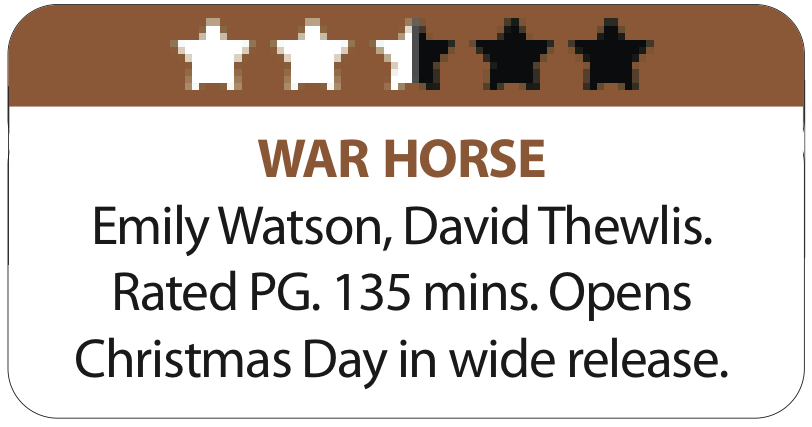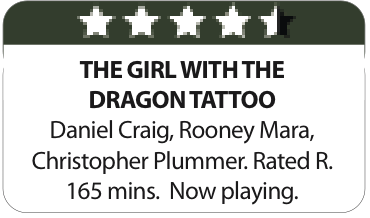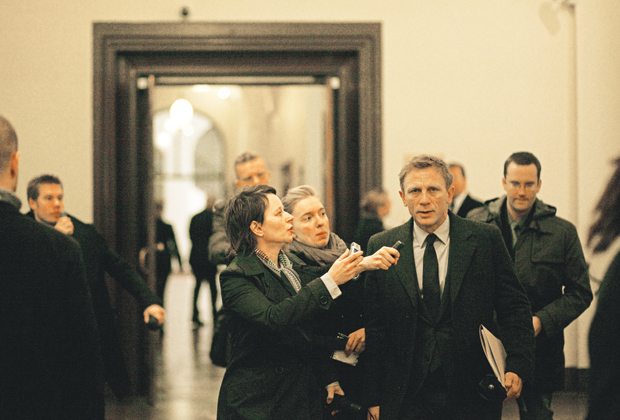Our guide to Christmas movies: ‘War Horse,’ ‘Girl with the Dragon Tattoo’
ARNOLD WAYNE JONES | Life+Style Editor
jones@dallasvoice.com
There’s something vaguely profane about opening War Horse on Christmas Day. True, it’s a heartwarming family film suitable to share with kids — Spielberg’s most gooily inoffensive film since E.T., in fact — but it’s also a movie where the main character is treated with the same reverence as the Christ Child. I mean that quite literally: From the moment his mare foals, people look at the Thoroughbred Joey with the awed humility of the Magi bestowing frankincense and myrrh.
War Horse, in fact, is so relentless in its nudging, reassuring you, This is a magical horse! This beast is special! Take your eyes off him at your peril!!! that it in fact loses almost all sense of genuine cinemagic. Imagine a comedian who spent more time telling you his jokes are the best and you’ll be wowed by how funny he is, and you approach the counterproductive quality of this movie.
 That’s surprising, because if anyone knows how to make wonder seem affectingly cinematic, it’s Spielberg. The moment the scientists see the living dinosaurs roaming about Jurassic Park is justified because freakin’ dinosaurs are walking among us!!! But a maverick quadruped at a livestock auction deserves it? Spielberg is getting soft. This is the most inept heartstring-tugging he’s done since Always, one of his few genuine flops, both commercially and artistically. And for someone who directed one of the great war movies of the modern era (Saving Private Ryan), this one contains tamely mediocre battle scenes. It doesn’t need to be a hard R, but World War I should look at least as harrowing as Saving Private Ryan.
That’s surprising, because if anyone knows how to make wonder seem affectingly cinematic, it’s Spielberg. The moment the scientists see the living dinosaurs roaming about Jurassic Park is justified because freakin’ dinosaurs are walking among us!!! But a maverick quadruped at a livestock auction deserves it? Spielberg is getting soft. This is the most inept heartstring-tugging he’s done since Always, one of his few genuine flops, both commercially and artistically. And for someone who directed one of the great war movies of the modern era (Saving Private Ryan), this one contains tamely mediocre battle scenes. It doesn’t need to be a hard R, but World War I should look at least as harrowing as Saving Private Ryan.
Still, it would be unfair to say War Horse has no merit. The reunion of boy and horse is memorably charming (Hey! You can’t seriously think I’m giving anything away), and Janusz Kaminski’s cinematography is staggeringly beautiful and versatile (the finale looks like it was lifted right out of the climax of Gone with the Wind). And Joey — at least, the computer-generated version of him — conveys a lot with a glance of those big eyes. It says a lot when the best performance in a movie is from a 2,000-lb. beast, and Oprah’s nowhere to be found.
When Stieg Larsson’s first book, The Girl with the Dragon Tattoo, debuted, it captured imaginations because it was at once a typical example of genre-fiction — the set-up, a sort of locked-room mystery about a girl who disappeared from a remote Swedish island 40 years earlier, invoked a standard whounnit structure — but also a deeply detailed screed against… well, against a lot of shit Larsson felt passionately about. Corporate control. Violence against women. Personal privacy. Journalistic ethics. By the time you sorted all those things out, you had a novel so plump with plots and subplots, it felt more like Tolstoy than Turow.
The Swedish-language film version, while altogether serviceable, had a rocky time balancing those elements, but this territory is right up director David Fincher’s alley. His English-language remake is almost as bleak as his modern quasi-masterpiece, Se7en, but the topics and the tone? Pure Fincher.
He declares his own stylish mantra during the opening credits: Organic, abstract, even desultory and festishistic images to Trent Reznor and Atticus Ross’ pulsating punk score establishes this as Fincher’s version of a Bond film. (It’s perhaps no coincidence the lead actor in the proposed trilogy is Bond himself, Daniel Craig.) Mechanical, urban, oppressive — welcome to the worlds of Larsson and Fincher.
 But The Girl with a Dragon Tattoo doesn’t weigh on you so much as it assaults you with its brazenness. The girl, Lisbeth (Rooney Mara), is a waifish and strange bisexual, antisocial to the point of psychopathic. She is clever but not subtle and without traditional cultural mores, so she has no problem hacking into the computers of industrialists if it suits her.
But The Girl with a Dragon Tattoo doesn’t weigh on you so much as it assaults you with its brazenness. The girl, Lisbeth (Rooney Mara), is a waifish and strange bisexual, antisocial to the point of psychopathic. She is clever but not subtle and without traditional cultural mores, so she has no problem hacking into the computers of industrialists if it suits her.
She eventually teams up with a disgraced journalist, Mikael (Craig), hired by a rich businessman (Christopher Plummer) to solve the enigma of what happened to his great niece on that summer day in 1965. That investigation leads down rabbit holes that uncover a serial killer half a century in the making, fueled by religious fervor and a Fascist past.
The pacing of this version has an energy the Swedish version did not, and Fincher excels during several violent ballets: A subway mugging, a harrowing rape scene (two rapes actually, but that may be saying too much), a chamber of horror torture sequence. He and screenwriter Steven Zaillian also streamline the plot, balancing Larsson’s philosophizing with dramatic tension (though they do tip their hand too soon with one key plot point and rushing some others.
Mara does a lot with a little; her Lisbeth is emotionally stunted but she moves and thinks deftly — she would be at home with Tom Cruise on the next Mission: Impossible. Craig also plays it close to the vest expertly. But the star is really Fincher, whose visually fluidity make you crave the next installment, and the next. It’s like Harry Potter for cynics.
………………….
•online exclusive
For reviews of The Artist, Tinker, Tailor, Soldier, Spy and A Dangerous Method, visit DallasVoice.com and click Screen.
This article appeared in the Dallas Voice print edition December 23, 2011.















